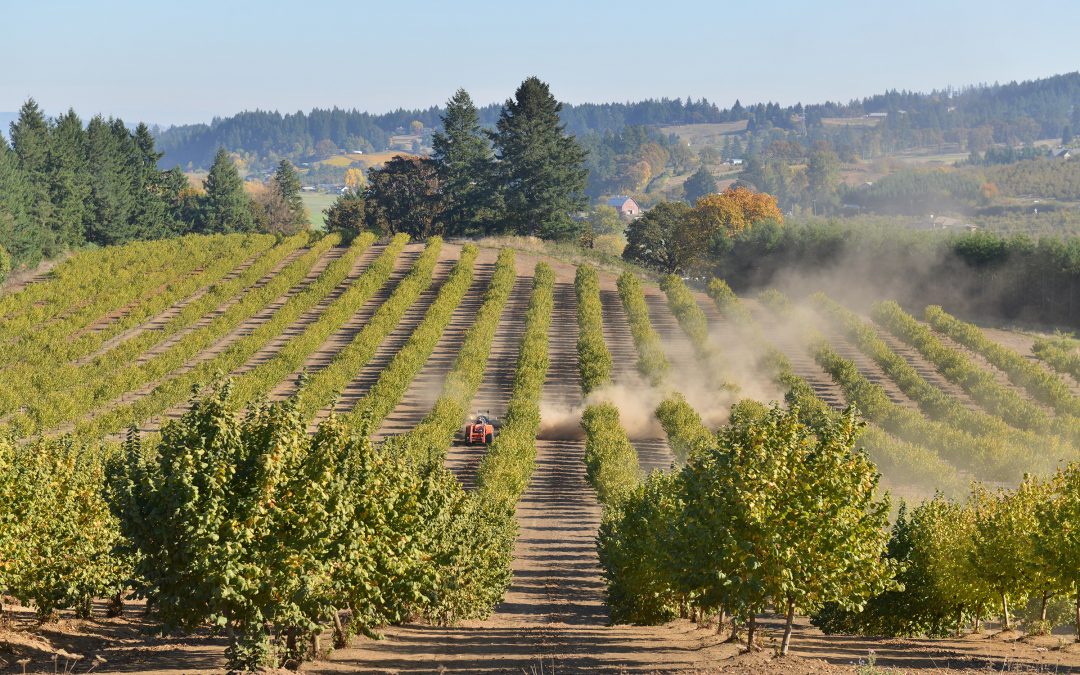Processing hazelnuts for the U.S. market
In August, with the 2018 harvest still on the trees, Hazelnut Growers of Oregon celebrated the opening of a 120,000-square-foot, state-of-the-art processing facility in Donald.
The farmer-owned organization, a division of Wilco Farmers Cooperative, represents more than 180 members. It also buys and sells hazelnuts from 80 non-member farmers.
The new facility is equipped with four massive silos capable of storing 5,400 tons of hazelnuts.
There were days at the peak of harvest when farmers delivered more than 500 tons Gabrish said.
George Packing Company and its sister business, Northwest Hazelnut Company, can also handle high volume. In September 2017 they opened a solar-powered plant in Hubbard and a year later added a finished goods plant to process and package kernels.
“I really believe that the time is right to move forward and introduce hazelnuts to the U.S. and to other channels,” Gabrish said.
He cites a 2017 Consumer Attitude and Usage Study conducted by the Hazelnut Marketing Board that found the primary reason people don’t consume more hazelnuts is that they haven’t tried them.
But once people try them, Gabrish said, “they like them and want to consume them in a lot more ways.”
Daniell Bliss has experienced this phenomenon in areas where she sells her Oregon City-made Bliss Nut Butters.
Her two hazelnut butters, one sweetened with honey and another studded with Oregon cranberries, each have a loyal following among farmers market customers.
“In the rural areas like Silverton, where people are familiar with hazelnuts, it sells like hotcakes … because those farmers grew up knowing that taste,” Bliss said.
Hazelnut coffee creamer has helped increase exposure to the nuts, said Polly Owen, director of the Hazelnut Marketing Board. “Even though there are no hazelnuts in it, it’s introduced people to the flavor.”
The board’s goal is to show both consumers and producers of foods that there are many uses for hazelnuts, savory as well as sweet.
In “any regular dish” said Owen, “adding hazelnuts adds value.”
What new hazelnut products may look like
Processors envision a future where grocery store shelves are stocked with Oregon hazelnut baking mixes, hazelnut granola is on the menu at the airport coffee kiosk, and hazelnuts stud energy bars.
Some larger food companies have begun exploring value-added products made with hazelnuts:
- Tillamook is including hazelnuts in several premium ice cream flavors.
- Pacific Foods, now a division of Campbell’s, has introduced a line of hazelnut milks, including a chocolate version.
- Milwaukie-based Bob’s Red Mill has begun producing a hazelnut meal, finely ground hazelnuts that can be used in gluten-free baking.
Adjacent to the entrance of Hazelnut Growers of Oregon’s new processing facility is a shop that sells 50-pound sacks of in-shell nuts, sachets of hazelnuts dipped in marionberry chocolate, and trays of hickory smoked, salted, and jalapeno-seasoned hazelnuts.
The products are labeled Oregon Orchard, a private label brand first developed by Troy Johnson in 1996.
Johnson worked for Hazelnut Growers of Oregon for a decade, but in 2014 he and his business partners founded Laurel Foods in Hillsboro to create a line of specialty grocery products showcasing Oregon hazelnuts.
They have begun production of hazelnut butter, a smoother, toastier recipe than that made by Bliss Nut Butters. They’re packing resealable bags of roasted and salted hazelnuts, and they’re pressing hazelnuts to make oil with a toasty aroma.
Johnson said he believes making processed products is a way for individual growers to differentiate themselves.
In Silverton, King Fresh is packaging local hazelnuts with gourmet seasonings: brown sugar, cinnamon, garlic parmesan, and ranch.
Freddy Guys Hazelnuts, in Monmouth, sells hazelnut pancake mix, hazelnut granola, and a mix for hazelnut pizza dough.
“The more things you can do with hazelnuts the more opportunities for other markets you can go into,” said Johnson
Naomi Inman, director of public relations and communications at Northwest Hazelnut Company, worked in partnership with Esotico pasta company to develop a hazelnut pasta as a gift to growers at an event.
The pasta has since become a local favorite at Esotico’s markets.
Inman hopes chefs, home cooks, and food businesses large and small continue to explore hazelnuts as a source of inspiration.
“It’s an exceptional ingredient and you can do so many things with it.”
Emily Teel is the Food & Drink Editor at the Statesman Journal. Contact her at eteel@statesmanjournal.com, Facebook, or Twitter. See what she’s cooking and where she’s eating this week on Instagram: @emily_teel








